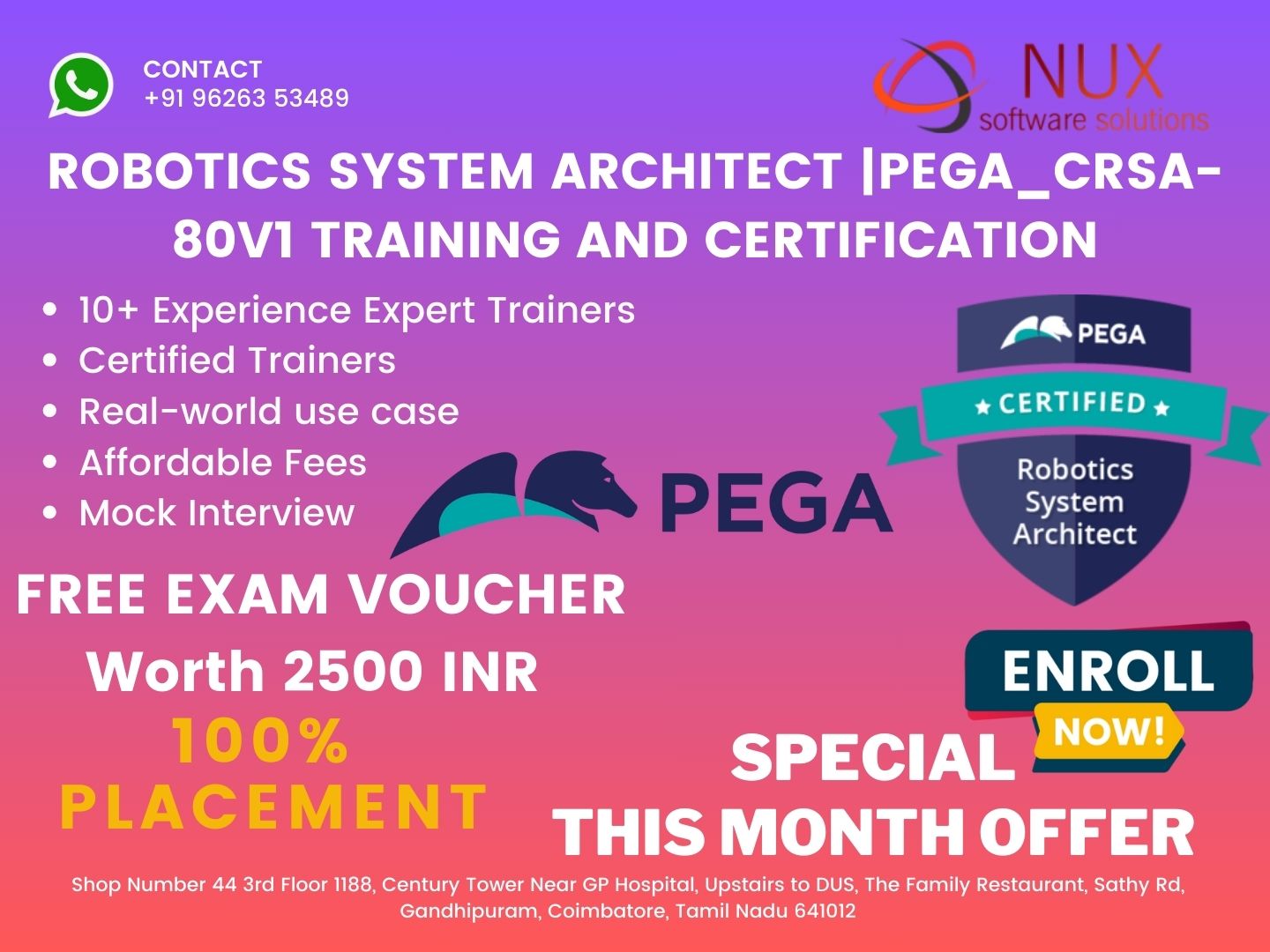Pega Robotics System Architect

Course Summary
The Pega Robotics System Architect course provides in-depth training on building and deploying automation solutions using Pega Robotic Process Automation (RPA) and Robotic Desktop Automation (RDA). Learners will explore how to design, develop, and manage bots that streamline repetitive tasks, improve accuracy, and increase operational efficiency across enterprise applications.
This course introduces participants to Pega Robot Studio, automations, adapters, and project deployment techniques, making it ideal for those looking to start a career in intelligent automation and RPA development.
Why Choose This Course
Automation is transforming the way businesses operate, and Pega Robotics is at the forefront of this shift. By enrolling in this course, you gain:
Hands-on experience with Pega Robot Studio and automation frameworks
Real-world project simulations across web, desktop, and legacy applications
Skills aligned with enterprise-grade automation delivery models
Practical exposure to Pega RPA bot design, error handling, and deployment
Training from certified professionals with industry RPA experience
This course sets you on the path to becoming a certified Pega Robotics System Architect and provides the technical depth needed to join automation teams across industries.
Who Should Enroll
This course is ideal for:
Developers and system analysts entering the RPA domain
IT professionals aiming to automate business processes
Workflow consultants and BPM practitioners looking to integrate robotics
Pega professionals expanding into automation and AI-enhanced delivery
Individuals preparing for the Pega Certified Robotics System Architect credential
What You Will Learn
By the end of this course, you will:
Understand the core concepts of RPA and RDA using the Pega Robotics platform
Build and configure automations using Pega Robot Studio
Work with adapters to integrate with desktop, web, and legacy applications
Manage events, interactions, and match rules to control bot behavior
Implement error handling, debugging, and logging techniques
Design modular, reusable automation components
Deploy and manage automations across Pega Robot Manager
Collaborate with business and IT stakeholders to streamline workflows
Skills You Will Gain
Proficiency with Pega Robot Studio development environment
Desktop and web application automation
Integration using Windows, web, and Citrix adapters
Automation logic design and interaction handling
Exception management and bot monitoring
Reusable component creation for scalable bots
Deployment best practices and bot lifecycle management
Career Benefits
Completing this course enables you to:
Pursue roles such as RPA Developer, Automation Engineer, or Robotics Consultant
Automate manual processes and improve productivity across IT and business teams
Contribute to digital transformation and AI/automation initiatives
Prepare for Pega’s Robotic System Architect certification
Stand out in industries like banking, healthcare, telecom, and insurance where automation is rapidly expanding
Start Automating Smarter – Enroll Today
Join the next generation of automation professionals. Learn how to design and deliver intelligent bots with Pega Robotics and help businesses boost efficiency and accuracy at scale.
Seats are limited. Register now.
Pega Robotics System Architect Syllabus
Introduction
Overview and Projects - 3%
- Identify the necessary architecture components for Pega Robotic Automations.
- Differentiate between the different architecture requirements for attended and unattended automations.
- Define the role of package storage in a Pega Robotic Automation.
- Communicate the role of Pega Robot Runtime in robotic automations and how it interacts with other applications.
- Describe the appropriate business use cases for Pega Robotic Process Automation.
- Explain what interrogation is in the context of a Pega Robotic Automation.
- Create a project through Quick Start.
- Describe the different project items in Pega Robot Studio.
- Navigate the Pega Robot Studio environment.
- Determine the correct Tool area of Pega Robot Studio based on development need.
Applications - 7%
- Recognize Pega Robot Studio application types.
- Recognize the most common applications used in Pega Robot Studio.
- Recognize the common Window application properties and values.
- Recognize the common Web application properties and values.
Interrogating and Recording - 15%
- Define the different types of step creation available in Intelligent Recording.
- Articulate the pros and cons of each type of step creation.
- Describe how to use the recording assistant after recording the steps for an automation.
- Describe interrogation within the context of a Pega Robotic Automation.
- Differentiate between the elements created during interrogation.
- Describe the purpose and use of the Interrogation Form.
- Differentiate between web and Windows interrogation.
- Restate the purpose of Global Web Pages during interrogation.
- Differentiate between different interrogation options on the Interrogation Form.
- Explain the purpose of performing application discovery.
- Describe when and how to use Microsoft Edge in IE compatibility mode.
- Restate the purpose of containers in a robotic project.
- Describe interrogating a single-page application.
- Articulate how to interrogate an HTML table.
Match Rules - 5%
- Restate how a robotic solution uses match rules during runtime.
- Relate best practices regarding match rules.
- Differentiate between the application of Windows and web-based match rules during interrogation.
- Differentiate between how web applications and IE compatible web applications match rules.
- Resolve common match rule situations and restate how controls can become unmatched.
- Explain the use of Xray Vision and its impact on application interrogation and automation development.
- Describe the purpose of UseKeys and how, once implemented, the UseKeys is applied within automation logic.
Automation Development - 20%
- Describe relationship between the Palette and automations.
- Describe the use of the Palette in automation development.
- Create an automation.
- Identify types of automation links and their relation to threading.
- Describe how automations are used with other automations and the project workflow.
- Create an automation as a sub-automation using the Label/Jump To components.
- Describe the importance of control availability in automation workflow.
- Describe how to access variable creation in a robotic automation.
- Restate the purpose of comparisons and expressions.
- Explain the expression input parameters.
- Describe the use of the utility components for strings, dates, times, and files.
- Differentiate the use and parameters of the Looping components.
- Describe the use and parameters of Wait components.
Advanced Automation and Best Practices - 15%
- Explain the use and development of Windows forms and application bars.
- Explain the scope and use of the Excel connector and other Microsoft Office connectors.
- Describe how to communicate with the user using messaging and notifications.
- Explain the importance and configuration of Assisted Sign-on.
- Differentiate between Start My Day and Assisted Sign-on.
- Recognize the uses for application methods and the Message Manifest feature.
- Describe the ways data flows between automation links and child blocks.
- Discover different approaches to working with data elements.
- Summarize the use of data elements on the automation surface.
- Identify how to add and switch between environments in your project.
Debugging and Diagnostics - 10%
- Recognize the reasons for using debugging for Pega Robot Studio.
- Implement the debugging process for the Run and Test modes.
- Use the keystrokes or toolbar options to step in, step over, and step out during a debugging process.
- Evaluate data values in an automation during debugging.
- Analyze the diagnostic settings to produce the necessary diagnostic log files.
- Implement a diagnostic log component to an automation to include specific text in a log file.
- Identify the new selections within the Tools menu to access the diagnostic log files.
- Use the project analysis feature to diagnose possible issues before deployment.
Pega Robotic Integration - 15%
- Differentiate the uses of attended and unattended uses and benefits.
- Differentiate between the architecture of how both attended and unattended automations function.
- Describe how and where to invoke automations.
- Recognize the which properties are available for data input/output for automations.
- Describe the statuses/messages returned by automations.
- Restate the necessary implementation options for messages for both attended and unattended automations.
- Configure the necessary settings for a robot activity to begin development of attended/unattended automations.
Deployment - 10%
- Identify the deployment package files.
- Define how to modify project properties for deployment.
- Recognize how to use the Project deployment dialog box to create and deploy packages.
Both Pega and veterans who’ve earned multiple certifications maintain that the best preparation for a Pega CPRSA professional certification exam is practical experience, hands-on training and practice exam. This is the most effective way to gain in-depth understanding of Pega PEGACPRSAV22 concepts. When you understand techniques, it helps you retain Pega Robotics System Architect knowledge and recall that when needed.



